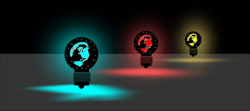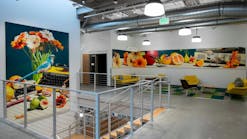A combination of government policies, steady improvements in light quality, and, above all, their undeniable energy efficiency has seen LEDs take over the lighting industry. At first glance, there doesn’t seem to be a downside to LEDification.
Let’s use the humble downlight as an example. The LED versions are clearly better than their halogen predecessors, with advantages such as various color temperature settings on a single luminaire and the capacity to be covered with insulation due to their low heat generation. Past the initial generations of general-purpose lamps, now you can buy smart lamps with color-changing and dimming effects at the touch of a mobile device. On the larger scale, the uptake of LEDs in sports lighting has changed the event and broadcast experience. It was never a surprise that Tottenham’s up-to-the-minute new stadium would go LED. The demands of super-slow replays are better met with LED illumination. Wimbledon’s retractable roof takes much longer to close than for its LED lights to come on and play to resume. The same can’t be said of metal halide technology, which needs as much of a warm-up as the players do.
Extravagant colored light shows at the new Perth Stadium in Australia would not have been economically feasible just a decade ago. Now the venue uses LED lighting that can be digitally controlled and fixtures don’t cost the earth to run. So why wouldn’t you enhance the entertainment experience at halftime with a light show? New buildings are frequently decorated with façade striplights in all the colors of the rainbow. Old bridges at night throw vibrant new reflections of themselves on the rivers and harbors they span. The reaction to the realization that LED is incredibly cheap to run has been a sudden proliferation of decorative lighting. People even put striplights under their beds, and hair salons outline their mirrors with “light bling.”
But is it possible that even as LEDs become more prevalent in the built environment, their use has over-saturated? Perhaps the efficiency gains from LEDs are being pulled back by the infamous Jevon’s Paradox or the rebound effect, which holds that reducing the cost of energy leads to increased consumption. It’s important to question this, and determine how best to leverage LED lighting capabilities without detriment to future market potential and causing unintended environmental consequences.
Looking to satellite studies
Although it is generally agreed that the world is steadily becoming more brightly lit, hard evidence is not easy to come by. But a study from 2017 published in Science Advances (“Artificially lit surface of Earth at night increasing in radiance and extent”) concluded that between 2012 and 2016 “continuously lit areas brightened at a rate of 2.2% per year.” This study depended on data from a satellite radiometer and observed that “The fact that the median country’s 15% increase in lighting from 2012 to 2016 nearly matched the median 13% increase in GDP [gross domestic product] suggests that outdoor light use remains subject to a large rebound effect on the global scale. Therefore, the results presented here are inconsistent with the hypothesis of large reductions in global energy consumption for outdoor lighting because of the introduction of solid-state lighting [SSL].”
Naturally, there are objections to these conclusions and some anomalies in the data such as thinly inhabited areas of Australia showing an increase in lighting due to bushfires. Advocates of LED efficiency point out that the study says nothing about the bulk of lighting indoors in offices and warehouses. However, most experts agree that there is a rebound effect to some extent that is eating into the promised efficiency gains of LED lighting. Just how much is a question of such byzantine complexity that it can’t really be sensibly answered.
Socket-saturation complication
LED companies such as one I worked for in Australia grew tremendously fast on the back of rapid uptake of a superior technology, but were steadily closing down their market at the same time by selling products with a 10‒15-year lifespan. It was all new customers and virtually no repeat business. That growth would inevitably flatline and decline. Their solution was to diversify into two areas — cheaper products with more potential for replacement, and smart lighting.
Naturally, neither of these things are driven by energy efficiency. They are about maintaining or increasing consumption and protecting the bottom line. Smart lighting was promoted as a lifestyle enhancement with applications for all sorts of connected appliances. And it came with a bigger price tag than your standard luminaire. A successful business can’t, after all, decide to become less profitable. Unfortunately, performance can be a problem with cheaper products, and smart lighting has yet to deliver on the promise of everyday ease of use, which leaves lighting companies seeking ways to differentiate beyond general commercial and residential illumination. New and emerging markets can drive innovation in LED technology, but it is likely that many companies will not survive to make headway in those areas.
Policy and sustainability pressures
The protection of jobs and the need to grow business mean that attempts in Australia to regulate the increasing amount of decorative lighting in new buildings has been met with determined resistance by the Lighting Council, the peak industry body in the country. Despite declaring on its website that one of its goals is that it “advocates the importance of energy efficient, quality, low environmental impact lighting products and systems,” modest limits on decorative lighting in new building regulations were characterized in a 2018 press release as likely to result in “Soviet-style buildings” and claimed that “a $400 million a year industry that creates over 2,500 jobs [is] facing the chopping block as a result of this frankly outrageous policy.” The organization cited the interests of lighting manufacturers, designers, specifiers, and related contractors in multiple subsequent announcements, in which it lobbied against the proposed changes to the National Construction Code.
Thus far, the lobby group has kept regulation at bay and remains determined to protect the interests of industry above what it perceives as government interference. Various policies around the globe have instigated a wide range of reactions from public interest groups and industry organizations. In some cases, as in the US, rollbacks of prior administrations’ energy policies have shown the potential to disrupt the advance of SSL, but stakeholders have also pushed back. In other scenarios, such as the new Ecodesign Directive and Energy Labelling Regulation changes in the EU, policies have been outlined to require more comprehensive product information for the consumer and provide energy use classifications for transparency. Still, there is little concrete information available as to how these policies have affected energy consumption attributed to LED lighting.
How do we balance the scales with SSL?
Just because an innovation delivers efficiencies, it doesn’t necessarily equate to less power being used. Instead of just pursuing savings, people also seize opportunities to increase usage with the attitude being if it’s cheap you can use more. If water costs hardly anything, the temptation is to water the garden as much as you like. But the reality is that over the last decade, LEDs have had more environmental clout than Greta Thunberg. The alternative would have been an increase in inefficient lighting being taken up by modernizing economies and growing populations. That said, some percentage of the reduction of energy that would have been used by conventional lighting has been offset by increased LED uptake in unexpected areas. The concern is that this percentage will increase. At what point does the zest for decoration have to be curtailed? What are LED companies going to do when socket saturation arrives? Indicators are that the steady move toward some global consensus on carbon reduction will compel regulation and that the market will force LED companies to innovate. The question is, how does the LED and SSL sector move from here to correct the imbalances of uptake and re-establish a roadmap for success?
Get to know our expert
DAVID ELLINGSEN is founder and owner of Metropolitan Plumbing, Electrical and Air Conditioning, part of Metropolitan Group Australia. With over 25 years of industry experience, Ellingsen knows exactly what his customers need and the best way to get them there. Electrical services include residential rewiring, lighting, meter servicing, and more.
For up-to-the-minute LED and SSL updates, why not follow us on Twitter? You’ll find curated content and commentary, as well as information on industry events, webcasts, and surveys on our LinkedIn Company Page and our Facebook page.





